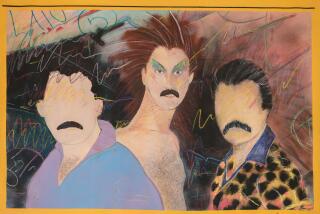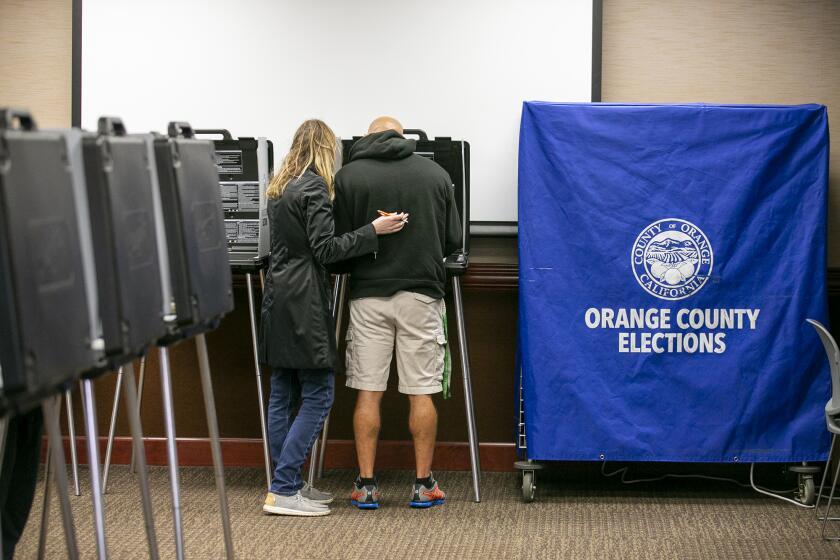California Biennial at the Orange County Museum of Art
In the 2008 California Biennial at the Orange County Museum of Art, the tour de force is an animatronic sculpture by Daniel J. Martinez. It resonates in many ways. ¶ Beneath bright white fluorescent lights, Martinez has constructed a low white platform in a large white room reached by a gently sloping ramp. Near one corner, a lifelike latex sculpture of a man lies on its back on the floor. Dressed in white pants and white shirt, with close-cropped hair and facial stubble, the figure appears deranged. ¶ Its eyes are rolled back, its teeth bared. A chunky, hip-hop-style silver belt buckle spells out the name “Ishmael.” At regular intervals, the reclining robot comes to mechanical life. ¶ An arm flops. A leg kicks. The head rolls forward and the torso twitches. ¶ When the flailing body parts hit the raised floor, it acts like a loud drum. The herky-jerky motion gets steadily more forceful, sometimes exposing the mechanical works beneath the floor that propel the man. The escalating racket is a cross between percussive music and a machine gun. It’s exciting, but there’s also a sense of relief when the figure finally pipes down and goes limp, returning to its static, soundless state. ¶ Ishmael, of course, is the narrator of Herman Melville’s “Moby-Dick,” in which he serves as a roving symbol for society’s outcasts. It is one measure of Martinez’s bracing audacity that he appropriates without hesitation an epic of American literary culture. The whiteness of the whale morphs into the abstract white cube of the modern art gallery -- as well as the dominance of European ancestry in contemporary culture. ¶ A bare white space is a popular emblem for a madhouse too. Martinez’s flailing figure -- notably, a self-portrait of the artist -- is crazed and kept down within an institutional context, both social and artistic. He’s also mechanically manipulated within it, unable to act independently.
So he does what artists do. The pounding of feet and fists might amount to little more than an adolescent temper tantrum, as if Edvard Munch’s “The Scream” had been theatrically retooled for the postmodern epoch of international exhibitionism. But it also makes mighty music, which you won’t soon forget.
OCMA’s Biennial -- CB08 for short -- includes 54 artists and collectives. Most invoke social and political subjects, themes that are always present in art but that take on an urgency in this moment of national elections and economic collapse. And the whole is firmly positioned against the proliferation of sleek, big-ticket, anonymously fabricated art.
Andrea Bowers shows a wicked unlimited-edition poster. The image is a photograph of an ad-hoc street poster affixed to an urban wall, making this museum piece a poster of a poster. In Spanish, the printed sheet in the photograph lists the White House telephone number.
The bed and cab of Jedediah Caesar’s red 1992 Toyota pickup are jammed full of the sort of roadside trash ubiquitous along the freeways, here returned to the home whence it all most likely came. Nearby, Tony Labat’s video “Mata Crush” choreographs the slow-motion wreckage of a Lincoln Continental limousine at an auto salvage yard. Waste up- on waste never looked so poetic.
Sam Durant has hoisted sunny Orange County tourist banners in front of the museum, with images of palms, surf and golf courses. They’re stamped in Spanish with familiar legends such as “We didn’t cross the border, it crossed us,” and “We aren’t criminals, we’re workers.” In majority-Republican O.C., does the “we” refer to immigrants or to artists -- or perhaps both?
Set on the floor, Erika Vogt’s ordinary 16-millimeter film projector merrily whirs on, even though the film has run out and is piled in a random mound around it. The enigmatic work evokes the end of an era -- The show’s over, go home -- but we can’t stop looking at its residue.
Gronk, better known for romantic and theatrical imagery, here turns those melodramatic adjectives in a darkly abstract direction, with a nice, monumental lobby wall-mural of all-over brown and deep blue calligraphic washes, sprinkled with modest chalk doodles. It’s like Abstract Expressionism gone mute, an exhausted existential utterance of profound silence.
Painting generally doesn’t fare well in the show. In addition to Gronk, the exceptions are Amanda Ross-Ho and Mary Weatherford.
On conventional canvases, Weatherford thinly paints abstract shapes that are layered or juxtaposed to suggest the entrances to dark, mysterious caves. Her cave paintings are frankly sexual, and they radiate a quiet sense of fecundity.
Ross-Ho has lined two walls of one gallery with big slabs of plasterboard cut from the walls of her studio. Whatever happened to be on those walls -- canvas remnants, a hip-hop poster, a dance mask, slathered paint, etc. -- or in front of them (a rolled-up tarp, some boxes) becomes conceptual still-life subjects. (What’s behind the walls does too: A dog collar and leash can be glimpsed in back of two panels. Where’s Fido?) Studio activity is asserted as the subject of museum art, and Ross-Ho eliminates the middleman.
I suppose Morgan Fisher’s white rectangles outside the front door on the sidewalk and inside on a gallery floor are also nominally paintings. A white rectangle is a familiar Modernist sign of purity. What’s provocative is that the dimensions of these were determined by the surface area of the artist’s body (3,332.5 square inches, to be precise). Walking all over them gives one pause.
CB08 was organized by guest curator Lauri Firstenberg, director of the nonprofit space LAXART in Culver City. She chose a group of artists -- including Bowers, Durant, Fisher, Labat, Martinez and several others -- whose work she believes has been formative for many of the younger artists in the show. Perhaps that’s true, but in some cases the question of influence bogs down the art.
Marcos Rios has built a large white room that’s just 5 feet 4 inches high -- reportedly the artist’s height -- for which I had to squat to enter, albeit to limited effect. Rios studied with Martinez, but the work is redolent of Bruce Nauman’s famous psychically disorienting corridors of the late 1960s, built to his own bodily dimensions.
Sarah Cain’s installation turns surrounding walls, a glass window and an outdoor sculpture court into a multidimensional walk-in painting, employing fabric, wallpaper, chains and ribbon as well as paint to do the trick. It’s lovely, but it’s also not nearly so inventive as the similar work Jessica Stockholder has made for years.
And out in front of OCMA’s building, Patrick Hebert has covered the lawn with literally hundreds of signs, like the kind that proliferate in yards during a political season. These mostly sport self-help slogans -- “I lack empathy,” “Asking for help is difficult for me” and so on -- transforming Jenny Holzer’s so-called truisms into self-possessed bric-a-brac.
Firstenberg has also organized 24 off-site presentations, by some artists who have works at OCMA and some who don’t, in venues as far afield as Tijuana, San Francisco, Joshua Tree and around Los Angeles. (A full schedule is available at the museum’s website.) The effort fits with the show’s loose theme of art’s social and political engagements, and metaphorically it lets Martinez’s furiously pounding artist out of the constricting white cube.
In effect, though, it dilutes rather than enhances the Biennial experience -- in which Martinez’s singular sculpture is a paradoxical standout. Almost no one can or will see the entirety of CB08, and that devalues the otherwise very real value a museum exhibition might have.
christopher.knight @latimes.com
More to Read
Get the Latinx Files newsletter
Stories that capture the multitudes within the American Latinx community.
You may occasionally receive promotional content from the Los Angeles Times.







